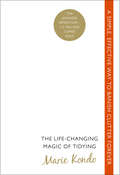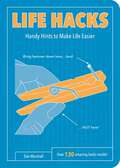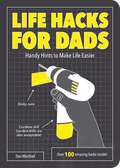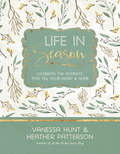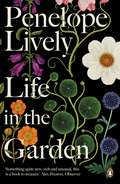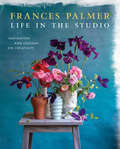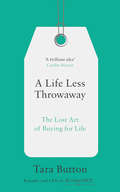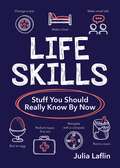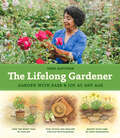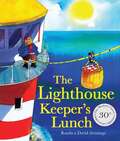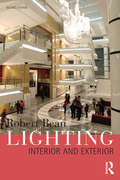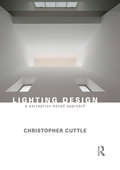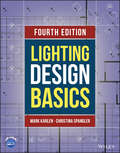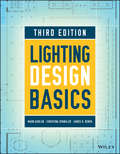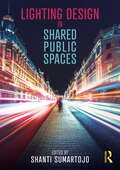- Table View
- List View
The Life-Changing Magic of Tidying: A simple, effective way to banish clutter forever
by Marie KondoMarie Kondo will help you declutter your life with her new major Netflix series Organise the World with Marie Kondo, coming soonTransform your home into a permanently clear and clutter-free space with the incredible KonMari Method. Japan's expert declutterer and professional cleaner Marie Kondo will help you tidy your rooms once and for all with her inspirational step-by-step method. The key to successful tidying is to tackle your home in the correct order, to keep only the things you really love and to do it all at once – and quickly. After that for the rest of your life you only need to choose what to keep and what to discard. The KonMari Method will not just transform your space. Once you have your house in order you will find that your whole life will change. You can feel more confident, you can become more successful, and you can have the energy and motivation to create the life you want. You will also have the courage to move on from the negative aspects of your life: you can recognise and finish a bad relationship; you can stop feeling anxious; you can finally lose weight.Marie Kondo's method is based on a 'once-cleaned, never-messy-again' approach. If you think that such a thing is impossible then you should definitely read this compelling book.
Life Hacks: Handy Tips to Make Life Easier (Life Hacks Ser.)
by Dan MarshallEver accidentally used your thumb as a hammer cushion while putting up a picture hook? Dozens of everyday dilemmas are solved with Life Hacks. This fully illustrated manual covers everything from nifty electric cable management to ingenious cooking methods and much, much more.
Life Hacks for Dads: Handy Hints to Make Life Easier (Life Hacks Ser.)
by Dan MarshallLife Hacks for Dads is your handy guide to making your daily life that little bit easier. This fully illustrated manual covers everything from keeping your car door wonderfully dent-free to making sure your kids stay entertained, and much, much more.
Life in Season: Celebrate the Moments That Fill Your Heart & Home
by Vanessa Hunt Heather PattersonThe authors of the wildly popular blog, At the Picket Fence, Heather and Vanessa share their inspiration, struggles, faith, and encouragement to women who, just like themselves, want a warm, God-centered, joy-filled life. Meditations, photographs, and simple, budget-friendly home décor tips and recipes are woven throughout Life In Season to help you celebrate the moments that fill your home, heart, and faith. Their easy-to-follow style and real-life stories prove that you don't need to consider yourself creative to create a home you will love.
Life in the Garden
by Penelope Lively'Rich and unusual, a book to treasure. Few recent gardening books come anywhere close to its style, intelligence and depth. Moves between Lively's own horticultural life and a broad history of gardening' Observer'Wonderful. A manifesto of horticultural delight' Literary Review'Beautiful. Perfect for literary garden lovers' Good Housekeeping'Exquisite and original' Daily Telegraph 'Enchanting. Reading this book is like walking with a wise, humorous guide through a series of garden rooms . . . and finding that vistas suddenly open out, on to history, fashion, politics, reflections on time and the taming of nature' Tablet'A perfect bedside book. In part it's a memoir of the gardens in Lively's life, starting with the exotic Egyptian garden of her childhood and continuing up to her small present-day garden in a north London square' Sunday Express'A gentle survey of the garden's place in Western culture, which morphs into a personal meditation on time, memory and a life well lived' i'Scholarly bedtime reading' The Times, Books of the Year
Life in the Soil: A Guide for Naturalists and Gardeners
by James B. NardiLeonardo da Vinci once mused that “we know more about the movement of celestial bodies than about the soil underfoot,” an observation that is as apt today as it was five hundred years ago. The biological world under our toes is often unexplored and unappreciated, yet it teems with life. In one square meter of earth, there lives trillions of bacteria, millions of nematodes, hundreds of thousands of mites, thousands of insects and worms, and hundreds of snails and slugs. But because of their location and size, many of these creatures are as unfamiliar and bizarre to us as anything found at the bottom of the ocean. Lavishly illustrated with nearly three hundred color illustrations and masterfully-rendered black and white drawings throughout, Life in the Soil invites naturalists and gardeners alike to dig in and discover the diverse community of creatures living in the dirt below us. Biologist and acclaimed natural history artist James B. Nardibegins with an introduction to soil ecosystems, revealing the unseen labors of underground organisms maintaining the rich fertility of the earth as they recycle nutrients between the living and mineral worlds. He then introduces readers to a dazzling array of creatures: wolf spiders with glowing red eyes, snails with 120 rows of teeth, and 10,000-year-old fungi, among others. Organized by taxon, Life in the Soil covers everything from slime molds and roundworms to woodlice and dung beetles, as well as vertebrates from salamanders to shrews. The book ultimately explores the crucial role of soil ecosystems in conserving the worlds above and below ground. A unique and illustrative introduction to the many unheralded creatures that inhabit our soils and shape our environment aboveground, Life in the Soil will inform and enrich the naturalist in all of us.
Life in the Studio: Inspiration and Lessons on Creativity
by Frances PalmerA handbook for leading a creatively fulfilling life, from renowned potter Frances Palmer.
A Life Less Throwaway: The Lost Art Of Buying For Life
by Tara ButtonNow more than ever, we live in a society where we covet new and shiny things. Not only has consumption risen dramatically over the last 60 years, but we are damaging the environment at the same time. That is why buying quality and why Tara Button’s Buy Me Once brand has such popular appeal.
Life Skills: Stuff You Should Really Know By Now
by Julia LaflinFull of useful advice and practical skills that everyone should know, this book will provide you with the essential knowledge you need to tackle life’s everyday challenges. From how to boil an egg to speaking in public, this handy guide will arm you with all the skills you need to navigate life in the real world like a pro.
Life Unstyled
by Emily HensonWe are bombarded by perfect interiors, images that aren’t attainable because they have been styled to the point where they bear no resemblance to reality. These interiors may be stunning, but they aren’t an honest reflection of how we really live.Life Unstyled is about taking inspiration from real homes that are beautiful, creative and inspiring but at the same time a little rough around the edges, with signs of everyday life evident throughout. The first section, ‘Homes Unstyled’, sets out Emily's manifesto for creating a stylish home that is beautiful but lived in. A Home is Never Done advocates allowing your space to evolve gradually so it is an ever-changing expression of your tastes and interests. Work with What You’ve Got suggests ways to make the most of the home you have rather than yearning for unattainable perfection. Signs of Life offers ideas for wrangling papers, clutter and other stuff. Creative Clutter tackles collections and displays, while Break the Rules rejects style diktats and shows how individuality can bring a home to life. The second section, ‘People Live Here’, visits real-life homes that are definitely not perfect yet display incredible style and creativity and reflect their owners’ needs, tastes and style. And throughout the book, quick fixes, DIY makes and ‘ Every Home Should Have…’ boxes offer creative solutions with unique results.
The Lifelong Gardener: Garden with Ease and Joy at Any Age
by Toni GattonePacked with dozens of tips and tricks for making gardening less physically demanding and more gratifying, this empowering guide is for avid gardeners who want to continue enjoying their favorite hobby at any age.
A Lifetime of Seasons: The Best of Christopher Lloyd
by Christopher Lloyd'He was the best informed, liveliest and most innovative gardening writer of our times' GUARDIAN'Infuriating, irascible ... a brilliant gardener and a brilliant writer' Monty Don, ObserverChristo Lloyd was recognised as one of the foremost gardeners and garden writers of the 20th century. Here, for the first time, is the definitive collection of his best, most informative, and so often amusing, garden writing.Christo on gardening: Ours, in its humble way, is an art as well as a craft. At the same time it keeps us in touch with the earth, the seasons, and with that complex of interrelated forces both animate and inanimate which we call nature. It is a humanizing occupation.On weeding: Many gardeners will agree that hand-weeding is not the terrible drudgery that it is often made out to be. Some people find in it a kind of soothing monotony. It leaves their minds free to develop the plot for their next novel or to perfect the brilliant repartee with which they should have encountered a relative's latest example of unreasonableness.
Light in Architecture: The Intangible Material
by Elisa Valero RamosLight in Architecture explores the role and use of light in and around buildings from the time that Stonehenge was built through to the present day, illustrating how a greater understanding of this intangible and free material will lead us to better architecture and, ultimately, improve our quality of life. Translated and carefully updated from the best-selling Spanish book, La Materia Intangible, this full colour edition explains why light is so fundamental to human perception, how its nature and use are influenced by time and place, and how it has come to be used as a tool for abstract architectural design. Drawing on centuries of thinking and over 40 real-life, international exemplars, the book explores the different ways that light can be harnessed and manipulated to achieve particular objectives, emotions or experiences, as well as how the technologies and techniques for doing so have developed over time.
Light in Architecture: The Intangible Material
by Elisa Valero RamosLight in Architecture explores the role and use of light in and around buildings from the time that Stonehenge was built through to the present day, illustrating how a greater understanding of this intangible and free material will lead us to better architecture and, ultimately, improve our quality of life. Translated and carefully updated from the best-selling Spanish book, La Materia Intangible, this full colour edition explains why light is so fundamental to human perception, how its nature and use are influenced by time and place, and how it has come to be used as a tool for abstract architectural design. Drawing on centuries of thinking and over 40 real-life, international exemplars, the book explores the different ways that light can be harnessed and manipulated to achieve particular objectives, emotions or experiences, as well as how the technologies and techniques for doing so have developed over time.
The Lighthouse Keeper's Lunch (The\lighthouse Keeper Ser.)
by Ronda Armitage David ArmitageAvailable for the first time as an ebook, THE LIGHTHOUSE KEEPER'S LUNCH is a modern classic, loved by children everywhere. Every day the lighthouse keeper tucks into a delicious lunch. But he isn't the only one who enjoys the tasty food. What will stop the greedy gulls from stealing the lighthouse keeper's lunch?
Lighting: Interior And Exterior
by Robert BeanThis comprehensive and practical guide takes you step-by-step through the core concepts and applications of architectural lighting. Now completely revised and updated for the second edition, this book: Includes all new information on the latest regulations and recommendations Provides special attention to the rapid development of LED lighting Considers the new CIE colour metric system Concludes each chapter with questions for the reader, together with inverted appropriate answers Features full colour throughout, for the first time, to support the text and aid the reader Covering a wide range of building types and external environments, this book shows how the concepts used in lighting design arise from the needs of the designer and user. These concepts are given a practical context to enable you to develop and improve your design skills, building up from the basics of how much light is needed and the role of shadows, to energy management and the calculations for daylighting, The author provides accessible, user-friendly explanations of technical information and specialist techniques intended for people who need to get to the heart of the subject as quickly as possible. An indispensible learning tool for students, and for professionals developing their skills, this handbook provides examples and exercises to help you acquire the understanding, knowledge and skill required for examinations and professional training purposes.
Lighting Design: A Perception-Based Approach
by Christopher CuttleBy reading this book, you will develop the skills to perceive a space and its contents in light, and be able to devise a layout of luminaires that will provide that lit appearance. Written by renowned lighting expert Christopher (Kit) Cuttle, the book: explains the difference between vision and perception, which is the distinction between providing lighting to make things visible, and providing it to influence the appearance of everything that is visible; demonstrates how lighting patterns generated by three-dimensional objects interacting with directional lighting are strongly influential upon how the visual perception process enables us to recognize object attributes, such as lightness, colourfulness, texture and gloss; reveals how a designer who understands the role of these lighting patterns in the perceptual process may employ them either to reveal, or to subdue, or to enhance the appearance of selected object attributes by creating appropriate spatial distributions of light; carefully explains calculational techniques and provides easy-to-use spreadsheets, so that layouts of lamps and luminaires are derived that can be relied upon to achieve the required illumination distributions. Practical lighting design involves devising three-dimensional light fields that create luminous hierarchies related to the visual significance of each element within a scene. By providing you with everything you need to develop a design concept - from the understanding of how lighting influences human perceptions of surroundings, through to engineering efficient and effective lighting solutions – Kit Cuttle instills in his readers a new-found confidence in lighting design.
Lighting Design: A Perception-Based Approach
by Christopher CuttleBy reading this book, you will develop the skills to perceive a space and its contents in light, and be able to devise a layout of luminaires that will provide that lit appearance. Written by renowned lighting expert Christopher (Kit) Cuttle, the book: explains the difference between vision and perception, which is the distinction between providing lighting to make things visible, and providing it to influence the appearance of everything that is visible; demonstrates how lighting patterns generated by three-dimensional objects interacting with directional lighting are strongly influential upon how the visual perception process enables us to recognize object attributes, such as lightness, colourfulness, texture and gloss; reveals how a designer who understands the role of these lighting patterns in the perceptual process may employ them either to reveal, or to subdue, or to enhance the appearance of selected object attributes by creating appropriate spatial distributions of light; carefully explains calculational techniques and provides easy-to-use spreadsheets, so that layouts of lamps and luminaires are derived that can be relied upon to achieve the required illumination distributions. Practical lighting design involves devising three-dimensional light fields that create luminous hierarchies related to the visual significance of each element within a scene. By providing you with everything you need to develop a design concept - from the understanding of how lighting influences human perceptions of surroundings, through to engineering efficient and effective lighting solutions – Kit Cuttle instills in his readers a new-found confidence in lighting design.
Lighting Design Basics
by Mark Karlen James R. BenyaLighting is a basic, yet difficult-to-master, element of interior design, and Lighting Design Basics provides the information you need in a concise, highly visual format. Two leading designers, both with decades of experience, offer straightforward coverage of concepts and techniques, and present realistic goals you can use as guides to creating simple, typical lighting designs and when collaborating with professional designers on more complex projects. Design scenarios for more than twenty different spaces illustrate real-world case studies for illuminating residential and commercial spaces, from kitchens to doctors' offices. Each scenario includes an in-depth rationale for the proposed solution, insightful lighting distribution diagrams, floor plans, and details for lighting installation and construction. In addition, exercises allow you to develop lighting design skills in preparation for working on actual projects, as well as the NCIDQ and NCARB exams. Packed with informative illustrations, Lighting Design Basics is an invaluable resource for students, as well as interior designers and architects studying for professional licensing exams.
Lighting Design Basics
by Mark Karlen Christina SpanglerLIGHTING DESIGN BASICS AN AUTHORITATIVE INTRODUCTION TO PROFESSIONAL LIGHTING DESIGN FOR ARCHITECTS, INTERIOR DESIGNERS, AND ENGINEERS Lighting is an essential component of any designed space, yet it is one of the most difficult right. Lighting Design Basics, 4th Edition provides a fundamental grounding in architectural lighting concepts, processes, and techniques that every student must master. The book offers a carefuly balanced combination of design and technology instruction and provides a great deal of graphic information, complete with plan, section, and three-dimensional drawings. The authors examine over 25 different design scenarios with in-depth rationales for proposed solutions, insightful distribution diagrams, floor plans, and details for lighting installation and construction. Immersive instruction on real-world settings accompanies practical guidance suitable for immediate application in everyday projects. Lighting can make or break any space, and design choices impact the cost and comfort of the building over the long term. Lighting Design Basics provides a critical foundation and prescriptive techniques to help future architects and interior designers make smart desing choices. This new edition provides readers with: A new chapter, entitled Light and Health, covering the physiological aspects of lighting design Updated LED technical content with coverage of light sources, luminaires, controls, quantity and quality of light, color rendition, and calculation software tutorials Explorations of industry codes and additional material on sustainable practices Thorough discussions of lighting in residences, workspaces, educational facilities, healthcare spaces, retail stores, and hospitality environments The basic skills required to become competent in the field, and prepare for the NCIDQ and NCARB exams Designed for undergraduate students in architecture and interior design, the latest edition of Lighting Design Basics is also valuable for working professionals in both fields who want to refresh their skills in lighting design and/or lighting technology
Lighting Design Basics
by Mark Karlen Christina SpanglerLIGHTING DESIGN BASICS AN AUTHORITATIVE INTRODUCTION TO PROFESSIONAL LIGHTING DESIGN FOR ARCHITECTS, INTERIOR DESIGNERS, AND ENGINEERS Lighting is an essential component of any designed space, yet it is one of the most difficult right. Lighting Design Basics, 4th Edition provides a fundamental grounding in architectural lighting concepts, processes, and techniques that every student must master. The book offers a carefuly balanced combination of design and technology instruction and provides a great deal of graphic information, complete with plan, section, and three-dimensional drawings. The authors examine over 25 different design scenarios with in-depth rationales for proposed solutions, insightful distribution diagrams, floor plans, and details for lighting installation and construction. Immersive instruction on real-world settings accompanies practical guidance suitable for immediate application in everyday projects. Lighting can make or break any space, and design choices impact the cost and comfort of the building over the long term. Lighting Design Basics provides a critical foundation and prescriptive techniques to help future architects and interior designers make smart desing choices. This new edition provides readers with: A new chapter, entitled Light and Health, covering the physiological aspects of lighting design Updated LED technical content with coverage of light sources, luminaires, controls, quantity and quality of light, color rendition, and calculation software tutorials Explorations of industry codes and additional material on sustainable practices Thorough discussions of lighting in residences, workspaces, educational facilities, healthcare spaces, retail stores, and hospitality environments The basic skills required to become competent in the field, and prepare for the NCIDQ and NCARB exams Designed for undergraduate students in architecture and interior design, the latest edition of Lighting Design Basics is also valuable for working professionals in both fields who want to refresh their skills in lighting design and/or lighting technology
Lighting Design Basics
by Mark Karlen Christina Spangler James R. BenyaA visual, real-world guide to professional lighting design Lighting Design Basics is the essential guide to this basic, but difficult-to-master aspect of interior design. Offering fundamental concepts and prescriptive techniques in a highly visual format, this book provides clear, practical guidance on utilizing the latest in lighting techniques and technology to showcase a space without sacrificing utility. Covering more than 25 different design scenarios with in-depth rationale for proposed solutions, this book provides insightful distribution diagrams, floor plans, and details for lighting installation and construction. Real-world case studies illustrate lighting design in residential, commercial, healthcare, education, and hospitality settings, and skill-building exercises offer practice for real-world projects as well as NCIDQ and NCARB exam preparation. This new third edition includes new instructor support materials, coverage of computer calculation software, and in-depth discussion on the latest in LED lighting. Lighting is changing, both in the technology itself, and in the way a designer must approach it. This book provides immersive instruction through real-world settings, and practical guidance suited for immediate application in everyday projects. Get up-to-date on the latest methods and technology for lighting design Examine more than 25 design scenarios for different types of spaces Complete exercises to hone your skills or prepare for the NCIDQ or NCARB Create simple lighting designs and collaborate with architects on complex projects Lighting can make or break a space. Improper lighting lends a space an uncomfortable feel, can induce headaches or eyestrain, and can even be hazardous—but thoughtfully designed and executed lighting adds that extra element so often missing from typical spaces. Lighting Design Basics shows you how to elevate any space through the fundamental tools and concepts of professional lighting design.
Lighting Design Basics
by Mark Karlen Christina Spangler James R. BenyaA visual, real-world guide to professional lighting design Lighting Design Basics is the essential guide to this basic, but difficult-to-master aspect of interior design. Offering fundamental concepts and prescriptive techniques in a highly visual format, this book provides clear, practical guidance on utilizing the latest in lighting techniques and technology to showcase a space without sacrificing utility. Covering more than 25 different design scenarios with in-depth rationale for proposed solutions, this book provides insightful distribution diagrams, floor plans, and details for lighting installation and construction. Real-world case studies illustrate lighting design in residential, commercial, healthcare, education, and hospitality settings, and skill-building exercises offer practice for real-world projects as well as NCIDQ and NCARB exam preparation. This new third edition includes new instructor support materials, coverage of computer calculation software, and in-depth discussion on the latest in LED lighting. Lighting is changing, both in the technology itself, and in the way a designer must approach it. This book provides immersive instruction through real-world settings, and practical guidance suited for immediate application in everyday projects. Get up-to-date on the latest methods and technology for lighting design Examine more than 25 design scenarios for different types of spaces Complete exercises to hone your skills or prepare for the NCIDQ or NCARB Create simple lighting designs and collaborate with architects on complex projects Lighting can make or break a space. Improper lighting lends a space an uncomfortable feel, can induce headaches or eyestrain, and can even be hazardous—but thoughtfully designed and executed lighting adds that extra element so often missing from typical spaces. Lighting Design Basics shows you how to elevate any space through the fundamental tools and concepts of professional lighting design.
Lighting Design in Shared Public Spaces
by Shanti SumartojoThis book advocates an approach to lighting design that focuses on how people experience illumination. Lighting Design in Shared Public Spaces contextualises light, dark and lighting design within the settings, sensations, ideas and imaginaries that form our understandings of ourselves and the world around us. The chapters in this collection bring a new perspective to lighting design, arguing for an approach that addresses how lighting is experienced, understood and valued by people. Across a range of new case studies from Australia, Germany, Denmark, and the United Kingdom, the authors account for lighting design’s crucial role in shaping our dynamic and messy experiential worlds. With many turning to innovative ethnographic methodologies, they powerfully demonstrate how feelings of comfort, safety, security, vulnerability, care and well-being can configure in and through how people experience and manipulate light and dark. By focusing on how lighting is improvised, arranged, avoided and composed in relation to the people and things it acts upon, the book advances understandings of lighting design by showing how improved experiences of the built environment can result from more sensitive and context-specific illumination. The book is intended for social scientists who are interested in the lit or sensory world, as well as designers, architects, urban planners and others concerned with how the experience of light, dark and lighting might be both better understood and implemented in our shared public spaces.
Lighting Design in Shared Public Spaces
by Shanti SumartojoThis book advocates an approach to lighting design that focuses on how people experience illumination. Lighting Design in Shared Public Spaces contextualises light, dark and lighting design within the settings, sensations, ideas and imaginaries that form our understandings of ourselves and the world around us. The chapters in this collection bring a new perspective to lighting design, arguing for an approach that addresses how lighting is experienced, understood and valued by people. Across a range of new case studies from Australia, Germany, Denmark, and the United Kingdom, the authors account for lighting design’s crucial role in shaping our dynamic and messy experiential worlds. With many turning to innovative ethnographic methodologies, they powerfully demonstrate how feelings of comfort, safety, security, vulnerability, care and well-being can configure in and through how people experience and manipulate light and dark. By focusing on how lighting is improvised, arranged, avoided and composed in relation to the people and things it acts upon, the book advances understandings of lighting design by showing how improved experiences of the built environment can result from more sensitive and context-specific illumination. The book is intended for social scientists who are interested in the lit or sensory world, as well as designers, architects, urban planners and others concerned with how the experience of light, dark and lighting might be both better understood and implemented in our shared public spaces.
